Gorilla Conservation Status in Africa is positive considering that more organizations are pulling resources together and the number of primates keep increasing. Africa is home to a variety of wildlife species that have over the years been of high social-economic benefit – making Africa one of the leading tourism destinations around the world. Despite these tremendous benefits, African wildlife species are facing extinction with the Mountain gorilla, Ethiopian wolf, Black Rhino, Rothchild`s Giraffe, Chimpanzee, African Penguin, Riverine Rabbit, African Wild Dog and the pickergrill`s Reedfrog among those listed by the International Union for Conservation of Nature (IUCN) in the Red list of Threatened species critical to protection and conservation.
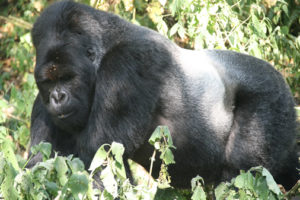 Mountain gorillas are one of the four types of gorillas in existence and can be found in the Virunga volcanic mountains found in south-western Uganda, North-West of Rwanda and the Eastern Democratic Republic of Congo found. The two main species are the lowland gorillas and the mountain gorillas. Lowland gorillas are further grouped into two sub-species – The Eastern and Western Lowland gorillas. Mountain gorillas are found within four national parks – Mgahinga Gorilla National Park in Uganda, Bwindi impenetrable National Park (Uganda), Virunga National Park (Congo) and the Volcanoes National park in Rwanda. Being predominantly terrestrial and quadrupedal, mountain gorillas posses longer and thicker fur than their cousins the lowland gorillas that enables them adapt to more cold temperatures. Adult males have a more pronounced bony crest with gray and silver colored hair on their backs that is developed with age hence the name silverback. Mountain gorillas weigh between 195kg to 200kg which is twice as much as their female counterparts. They have arms stretching longer than its legs and moving in a knuckle walking position supporting its weight by the backs of it`s curved fingers.
Mountain gorillas are one of the four types of gorillas in existence and can be found in the Virunga volcanic mountains found in south-western Uganda, North-West of Rwanda and the Eastern Democratic Republic of Congo found. The two main species are the lowland gorillas and the mountain gorillas. Lowland gorillas are further grouped into two sub-species – The Eastern and Western Lowland gorillas. Mountain gorillas are found within four national parks – Mgahinga Gorilla National Park in Uganda, Bwindi impenetrable National Park (Uganda), Virunga National Park (Congo) and the Volcanoes National park in Rwanda. Being predominantly terrestrial and quadrupedal, mountain gorillas posses longer and thicker fur than their cousins the lowland gorillas that enables them adapt to more cold temperatures. Adult males have a more pronounced bony crest with gray and silver colored hair on their backs that is developed with age hence the name silverback. Mountain gorillas weigh between 195kg to 200kg which is twice as much as their female counterparts. They have arms stretching longer than its legs and moving in a knuckle walking position supporting its weight by the backs of it`s curved fingers.
Mountain Gorilla Conservation – Population and Census
Between 1959 and 1960, the population of Mountain gorillas had been fluctuating. The first Gorilla census carried out by George Schaller estimated between 400 to 500 individuals in virunga conservation area. This was then followed by the 1971 and 1973 gorilla censuses carried out by Dian Fossey and her Karisoke Research Center team which showed a dramatic decline in Gorilla numbers down to 250. This decline was attributed to increased poaching coupled with the loss of up to 40 percent of volcanoes National park land to agricultural cultivates. 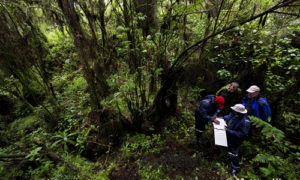 The 1978 census by the Karisoke Research center found about 260 gorillas with 42 infants below the age of three years. The number increased to approximately 320 in Bwindi impenetrable forest and 324 in the Virunga conservation area during the 1989 census following the death of Dian Fossey in 1985. The number gradually rose to 380 and 480 in 2003 and 2010 respectively in the Virunga conservation area showing a 26.3% increase in gorilla population over a period of seven years. Unlike in the Virunga volcanoes, census in Bwindi impenetrable forest were carried out differently with the 1997 gorilla census revealing a total of 300 individuals rising to 320 in 2002. This however declined to 302 in the 2006 population census. A total of 682 mountain gorillas were found in the 2006 gorilla census in both the Virunga region and Bwindi impenetrable national parks with a further 138 increase in 2012 and over 1000 mountain gorillas in the wild in the most recent 2018 gorilla census.
The 1978 census by the Karisoke Research center found about 260 gorillas with 42 infants below the age of three years. The number increased to approximately 320 in Bwindi impenetrable forest and 324 in the Virunga conservation area during the 1989 census following the death of Dian Fossey in 1985. The number gradually rose to 380 and 480 in 2003 and 2010 respectively in the Virunga conservation area showing a 26.3% increase in gorilla population over a period of seven years. Unlike in the Virunga volcanoes, census in Bwindi impenetrable forest were carried out differently with the 1997 gorilla census revealing a total of 300 individuals rising to 320 in 2002. This however declined to 302 in the 2006 population census. A total of 682 mountain gorillas were found in the 2006 gorilla census in both the Virunga region and Bwindi impenetrable national parks with a further 138 increase in 2012 and over 1000 mountain gorillas in the wild in the most recent 2018 gorilla census.
Gorilla Conservation and Protection
Despite these encouraging figures of continually rising numbers in mountain gorilla population over the past years, these mighty apes still face several threats resulting from human behaviors that is believed to have once almost brought the primates to extinction in the early 1970`s. These threats can largely be classified into Social, Economic and Political situations brought about by human primarily.
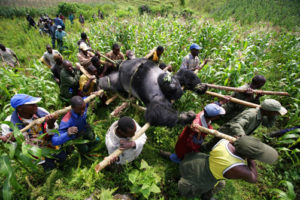 As years move on, human populations keep rising by the day. This has seen forests encroached upon for human settlements, agricultural and pastoral activities. This has resulted in the loss of habitat, breeding and feeding grounds for the mountain gorillas. Due to lack of food, the mountain gorillas are then tempted to feed on the human farm plantations that attracts retaliation from the opposing end. Increased human interactions with mountain gorillas in terms of settlements and tourism activities like gorilla trekking increase the chances of human infectious disease such as pneumonia, flu and recently Ebola to these mountain gorillas. Disease has accounted for at least 20% sudden death rates among the gorilla populations. Increased economic needs by humans have also seen a rise in poaching using traps and snares. Poaching can be lucrative due to the fact that mountain gorillas especially infant fetch up to a tune of $5000 in the black market. Still to consider, is the great threat posed to mountain gorillas as a result of political unrest coupled by civil wars seen over the past decades in Uganda, Rwanda, Democratic Republic of Congo. Civil and political crisis in DR Congo, has led to the loss of an estimated four million lives within a period of just more than a decade. This civil and political unrest has not only led to deaths of mountain Gorillas but also loss of habitat as civilians overcrowd the refugee settlements. Climatic change has also been found to be a threat Mountain gorillas have specific traits like productive rates and genetic variations that make them vulnerable to diverse climatic changes.
As years move on, human populations keep rising by the day. This has seen forests encroached upon for human settlements, agricultural and pastoral activities. This has resulted in the loss of habitat, breeding and feeding grounds for the mountain gorillas. Due to lack of food, the mountain gorillas are then tempted to feed on the human farm plantations that attracts retaliation from the opposing end. Increased human interactions with mountain gorillas in terms of settlements and tourism activities like gorilla trekking increase the chances of human infectious disease such as pneumonia, flu and recently Ebola to these mountain gorillas. Disease has accounted for at least 20% sudden death rates among the gorilla populations. Increased economic needs by humans have also seen a rise in poaching using traps and snares. Poaching can be lucrative due to the fact that mountain gorillas especially infant fetch up to a tune of $5000 in the black market. Still to consider, is the great threat posed to mountain gorillas as a result of political unrest coupled by civil wars seen over the past decades in Uganda, Rwanda, Democratic Republic of Congo. Civil and political crisis in DR Congo, has led to the loss of an estimated four million lives within a period of just more than a decade. This civil and political unrest has not only led to deaths of mountain Gorillas but also loss of habitat as civilians overcrowd the refugee settlements. Climatic change has also been found to be a threat Mountain gorillas have specific traits like productive rates and genetic variations that make them vulnerable to diverse climatic changes.
Mountain Gorilla Conservation
Mountain gorilla conservation efforts started as early as the 1970`s after the arrival of Dian Fossey to Rwanda. Dian Fossey was an American primatologist who devoted her life to mountain gorilla research and finding alternative solutions to help conserve the continually falling number of mountain gorillas in East Africa. You can pay homage to Dian Fossey by checking out our 3 Days Dian Fossey Hike and Gorilla Trekking. 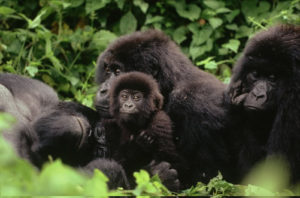 To date, mountain gorilla conservation efforts across Africa have been bench marked to three categories – Active, theoretical and community based activities to help curb the problems concerning mountain gorillas within the region. Governments in collaboration with other gorilla conservation organizations have then been actively involved in conservation efforts by coming up with and Implementing policies driven towards achieving a common goal of a threat free mountain Gorilla population. The main players in mountain gorilla conservation are the African Wildlife Foundation, Fauna and flora International and the World Wild Fund for Nature. They jointly established the International Gorilla Conservation Programme (IGCP) in 1991 to become the forefront programme on mountain gorilla conservation.
To date, mountain gorilla conservation efforts across Africa have been bench marked to three categories – Active, theoretical and community based activities to help curb the problems concerning mountain gorillas within the region. Governments in collaboration with other gorilla conservation organizations have then been actively involved in conservation efforts by coming up with and Implementing policies driven towards achieving a common goal of a threat free mountain Gorilla population. The main players in mountain gorilla conservation are the African Wildlife Foundation, Fauna and flora International and the World Wild Fund for Nature. They jointly established the International Gorilla Conservation Programme (IGCP) in 1991 to become the forefront programme on mountain gorilla conservation.
Conservation efforts have mainly focused on attaining a balance between meeting the diverse and ever growing needs of communities and preservation of breeding grounds for mountain gorillas. To achieve this, community based and individual analysis has taken the forefront. Strategies have been taken to achieve a sustainable livelihood through economically empowering these masses in alternative revenue generating projects to substitute deforestation and uncontrolled natural resource access within the protected regions. 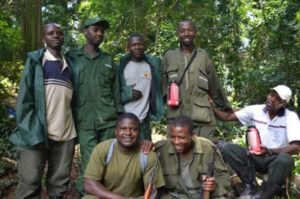 This has seen communities leasing lands to expand on the protected areas and also trust funds generated through gorilla tourism help develop and bring services to the communities and help support sustainable agriculture. Other efforts such as involving communities in decision making and sensitization of importance of conserving wildlife have also taken root. Other than community-based efforts such as improved lodging and infrastructure, park headquarter renovations have been done to encourage tourism. Other gorilla conservation activities include periodic gorilla census counts on the concentrated mountain gorilla habitats, ranger patrols, disabling of set traps, on ground law enforcement and safeguards of protected areas.
This has seen communities leasing lands to expand on the protected areas and also trust funds generated through gorilla tourism help develop and bring services to the communities and help support sustainable agriculture. Other efforts such as involving communities in decision making and sensitization of importance of conserving wildlife have also taken root. Other than community-based efforts such as improved lodging and infrastructure, park headquarter renovations have been done to encourage tourism. Other gorilla conservation activities include periodic gorilla census counts on the concentrated mountain gorilla habitats, ranger patrols, disabling of set traps, on ground law enforcement and safeguards of protected areas.
Mountain Gorilla tourism remains an important asset to countries where they are found since it gives them a comparative advantage over neighboring countries through the revenue it fetches annually. Hence there is need for Rwanda, Uganda, and the Democratic Republic of Congo to harmonize tourism activities and conservation efforts to get the full benefits of gorilla trekking.

